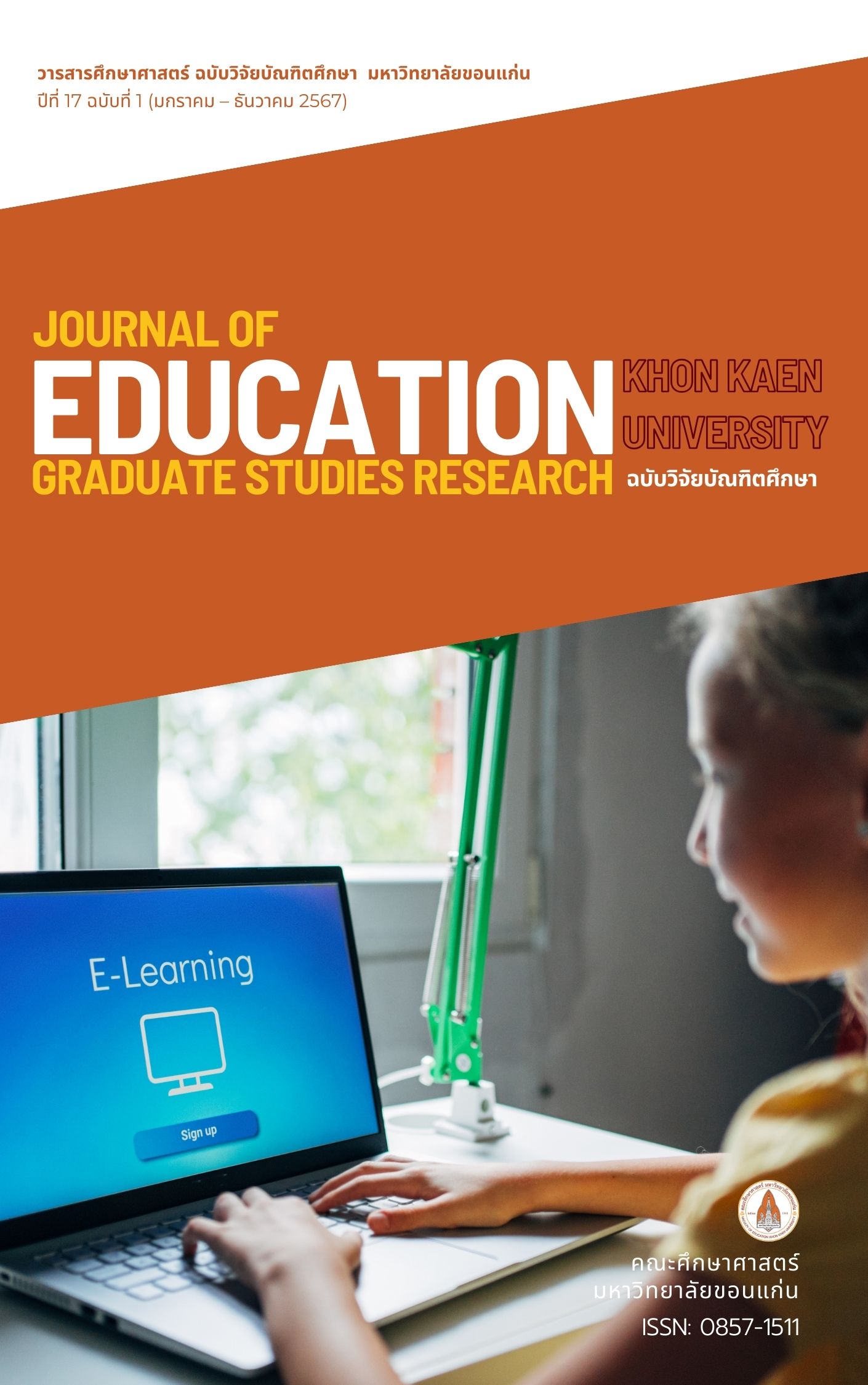The Development of Learning Innovation on Digital Platform Based on Constructivist Theory with Animated Cartoons to Promote Critical Thinking Skills and Learning Achievement of Grade 3 Students
Main Article Content
Abstract
This research aims to design and develop a learning innovation on a digital platform based on constructivist theory combined with animation to enhance critical thinking skills and academic achievement of Grade 3 students in the subject of Computational Science, specifically in the unit on using the internet to search for knowledge. The research process is divided into three phases 1) Designing and developing the innovation, 2) Validating the innovation, and 3) Implementing the innovation. Various tools were used, including measurement tools, tests, interviews, and both quantitative and qualitative data analysis. The research findings are as follows 1) The learning innovation consists of six key components problem situations, knowledge repository, cognitive tools, collaborative learning, scaffolding, and consulting. Experts evaluated the internal validity to be very high in all aspects. 2) The critical thinking skills of students after using the innovation were significantly higher than before at the .01 level, indicating that the developed innovation effectively enhances the critical thinking skills of Grade 3 students. 3) The academic achievement of students after using the innovation was significantly higher than before at the .01 level, reflecting the effectiveness of the learning innovation in improving the academic performance of the sample students and 4) The students' overall satisfaction with the learning innovation was at the highest level, with the highest satisfaction in the learning materials, followed by learning support, content, activities, and interaction. The evaluation aspect had the lowest satisfaction, albeit still at a high level.
Article Details

This work is licensed under a Creative Commons Attribution-NonCommercial-NoDerivatives 4.0 International License.
References
กนกวรรณ เชื้อบ่อคา. (2563). การษฎีสรรคนิยม (Constructivism) โดยใช้เทคโนโลยีสารสนเทศ และการสื่อสารเพื่อส่งเสริมการเรียนรู้และนวัตกรรมในศตวรรษที่ 21. วารสารวิชาการและวิจัย สถาบันเทคโนโลยีแห่งสุวรรณภูมิ, 6(1), 142-151
กนกวรรณ เชื้อบ่อคา. (2563). การจัดการเรียนรู้ตามแนวทฤษฎีสรรคนิยม (Constructivism) โดยใช้เทคโนโลยีสารสนเทศ และการสื่อสารเพื่อส่งเสริมการเรียนรู้และนวัตกรรมในศตวรรษที่ 21. วารสารวิชาการและวิจัย สถาบันเทคโนโลยีแห่งสุวรรณภูมิ, 6(1), 142-151.
ขวัญหทัย ยิ้มละมัย. (2563). การพัฒนาผลสัมฤทธิ์ทางการเรียนโดยใช้การ์ตูนแอนิเมชัน เรื่อง ประวัติศาสตร์สมัยอยุธยา สำหรับนักเรียนชั้นมัธยมศึกษาปีที่ 2. Journal of Sakon Nakhon Rajabhat University, 12(29), 41-52.
ขวัญหทัย ยิ้มละมัย. (2563). การพัฒนาผลสัมฤทธิ์ทางการเรียนโดยใช้การ์ตูนแอนิเมชัน เรื่อง ประวัติศาเรียนชั้นมัธยมศึกษาปีที่ 2. Journal of Sakon Nakhon Rajabhat University, 12(29), 41-52.
จารุวรรณ กันทะวงค์. (2563). การพัฒนาความสามารถในการคิดอย่างมีวิจารณญาณ โดยใช้การจัดการเรียนรู้ด้วยเทคนิค KWLH Plus สำหรับนักเรียนชั้นประถมศึกษาปีที่ 6. Journal of Education Naresuan University, 22(3), 13-25.
ชยากร หนูนิล. (2565). ผลการจัดการเรียนรู้ด้วยวิธีการใช้ปัญหาเป็นฐานที่มีต่อผลสัมฤทธิ์ทางการเรียนวิทยาศาสตร์และความสามารถในการแก้ปัญหาทางวิทยาศาสตร์ของนักเรียนชั้นมัธยมศึกษาปีที่ 2. Princess of Naradhiwas University Journal of Humanities and Social Sciences, 8(1), 201-214.
ธีรพงษ์ พวงมะณี. (2563). การ์ตูนแอนิเมกฤษ. วารสารครุศาสตร์ จุฬาลงกรณ์มหาวิทยาลัย, 48(4), 547-562
ธีรพงษ์ พวงมะณี. (2563). การ์ตูนแอนิเมชันเพื่อการเรียนรู้ภาษาอังกฤษ. วารสารครุศาสตร์ จุฬาลงกรณ์มหาวิทยาลัย, 48(4), 547-562.
ปิยะพงษ์ ปานทอง. (2563). การพัฒนาสื่อการเรียนรู้ด้วยการ์ตูนแอนิเมชัน 2 มิติ เรื่อง อาเซียนศึกษา สำหรับนักเรียนชั้นประถมศึกษาปีที่ 3. Valaya Alongkorn Review, 10(2), 95-106.
พรทิพย์ ทิพย์สุข. (2564). การประยุกต์ใช้ทฤษฎีการเรียนรู้คอนสตรัคติวิสต์ในการจัดการเรียนการสอนยุคดิจิทัล. Veridian E-Journal Silpakorn University, 14(3), 2101-2117
พัชราภรณ์ เลิศสถิตย์ธนกุล. (2563). ผลการจัดกิจกรรมการเรียนรู้ตามทฤษฎีคอนสตรัคติวิสต์โดยใช้โปรแกรม GeoGebra ที่มีต่อผลสัมฤทธิ์ทางการเรียนคณิตศาสตร์และทักษะกตร์ เรื่องความน่าจะเป็นของนักเรียนชั้นมัธยมศึกษาปีที่ 3. Journal of Education Naresuan University, 22(4), 178-191.
พิชญ์สินี เนียมทรัพย์. (2565). การจัดการเรียนรู้บนเครือข่ายตามทฤษฎีคอนเนคติวิสต์เพื่อส่งเสริมทักษะการรู้ดิจิทัล. Veridian E-Journal Silpakorn University, 15(2), 2565-2582.
ภูวิศา เธียรประสิทธิ์. (2564). การใช้แอนิเมชันเพื่อส่งเสริมทักษะการคิดอย่างมีวิจารณญาณในวิชาภาษาไทย สำหรับนักเ Journal of Graduate School Pitchayatat, 14(2), 61-72.
ยุพาวรรณ ทองตะนุนาม. (2563). สภาพปัจจุบันของการจัดการเรียนรู้ที่ส่งเสริมทักษะในศตวรรษที่ 21 ของนักเรียนชั้นมัธยมศึกษาตอนต้น สังกัดสำนักงานเขตพื้นที่การศึกษามัธยมศึกษา เขต 2. Rommayasan, 18(2), 24-36.
รัตติกร แสนราช. (2563). การพัฒนาทักษะการคิดอย่างมีวิจารณญาณบใช้การ์ตูนแอนิเมชัน สำหรับนักเรียนชั้นประถมศึกษาปีที่ 4. Journal of Roi Et Rajabhat University, 14(1), 79-89
รัตติกร แสนราช. (2563). การพัฒนาทักษะการคิดอย่างมีวิจารณญาณโดยการจัดการเรียนรู้แบบใช้การ์ตูนแอนิเมชัน สำหรับนักเรียนชั้นประถมศึกษาปีที่ 4. Journal of Roi Et Rajabhat University, 14(1), 79-89.
วรนาถ แสงมณี. (2564). การพัฒนารูปแบบการเรียนการสอนตามแนวคอนสตรัคติวิสต์ เพื่อส่งเสริมผลสัมฤทธิ์ทางการเรียนวิชาคณิตศาสตร์และความสามารถในการแก้ปัญหาทางคณิตศาสตร์ สำหรับนักเรียนชั้นมัธยมศึกษาปีที่ 1. Journal of Education Studies, 49(2), 85-101.
วรนาถ แสงมณี. (2564). การพัฒนารูปแบบการเรียนการสอนตามแนวคอนสตรัคติวิสต์ เพื่อส่งเสริมผลสัมฤทธิ์ทางการเรียนวิชาคณิตศาสตร์แก้ปัญหาทางคณิตศาสตร์ สำหรับนักเรียนชั้นมัธยมศึกษาปีที่ 1. Journal of Education Studies, 49(2), 85-101
วราภรณ์ คงสุวรรณ. (2564). การพัฒนาหลักสูตรฝึกอบรมการรู้ดิจิทัลสำหรับครู โรงเรียนเทศบาลวัดมเหยงคณ์ จังหวัดนครศรีธรรมราช. Journal of Humanities and Social Sciences Thonburi University, 16(1), 207-216.
สิริพัชร์ เจษฎาวิโรจน์. (2563). การจัดการเรียนรู้ฐานสมรรถนะ. กรุงเทพฯ: บริษัท เอ็น อาร์ พริ้นติ้ง แมส โปรดักส์ จำกัด.
สุภัทรา อักษรานุเคราะห์. (2561). การใช้แอนิเมชันเพื่อพัฒนาความเข้าใจในกาเรียนชั้นประถมศึกษาปีที่ 5. Journal of Education Naresuan University, 20(4), 221-233.
อลิสา ารออกแบบและพัฒนาคอร์สแวร์เพื่อการเรียนรู้ด้วยตนเองแบบออนไลน์ตามแนวคอนสตรัคติวิสต์. วารสารศึกษาศาสตร์ มหาวิทยาลัยบูรพา, 34(2), 56-68
อัจฉรา วิชาคำ. (2562). ผลของสิ่งแวดล้อมทางการเรียนรู้บนเครือข่ายตามแนวทฤษฎีคอนสตรัคติวิสต์ที่ส่งเสริมกการสร้างงานกราฟิก สำหรับนักเรียนระดับประกาศนียบัตรวิชาชีพ. วารสารวิจัย มข. สาขามนุษยศาสตร์และสังคมศาสตร์ (ฉบับบัณฑิตศึกษา), 8(1), 77-88
อิราวรรส พูนผล. (2564). การออกแบบและพัฒนาโมเดลสิ่งแวดล้อมทางการเรียนรู้แบบเคลื่อนที่ (Mobile Learning) ตามแนวคอนสตรัคติวิสต์ที่ส่งเสริมความคิดสร้างสรรค์ สำหรับนักเรียนชั้นมัธยมศึกษาตอนปลาย. วารสารศึกษาศาสตร์ มหาวิทยาลัยขอนแก่น, 44(4), 151-168
Collins, A., Brown, J. S., & Newman, S. E. (1991). Cognitive apprenticeship: Making thinking visible. American Educator, 15(3), 6-11.
Flavell, J. H. (1979). Metacognition and cognitive monitoring: A new area of cognitive–developmental inquiry. American Psychologist, 34(10), 906-911.
Getenet S. (2021). Constructhe digital age: The effect of using digital tools in a mathematics classroom. International Journal of Mathematical Education in Science and Technology, 52(7), 1047-1062
Getenet S. (2021). Constructivist learning in the digital age: The effect of using digital tools in a mathematics classroom. International Journal of Mathematical Education in Science and Technology, 52(7), 1047-1062.
Hannafin, M. J., & Land, S. M. (1997). The foundations and assumptions of technology-enhanced student-centered learning environments. Instructional Science, 25(3), 167-202.
Herrington, J., & Oliver, R. (2000). An instructional design framework for authentic learning environments. Educational Technology Research and Development, 48(3), 23-48.
Jonassen, D. H. (1996). Computers in the classroom: Mindtools for critical thinking. Englewood Cliffs, NJ: Prentice Hall.
Klausmeier, H. J. (1985). Educational psychology. New York: Harper & Row.
Larsson, K. (2017). Understanding and teaching critical thinking—A new approach. International Journal of Educational Research, 84, 32-42
Licorish S. A., Owen H. E., Daniel B., & George J. L. (2018). Students’ perception of Kahoot!’s influence on teaching anch and Practice in Technology Enhanced Learning, 13(1), 1-23
Mayer, R. E. (1990). Multimedia learning: Are we asking the right questions? Educational Psychologist, 32(1), 1-19.
Paul, R., & Elder, L. (2019). Critical thinking: Tools your learning and your life (4th ed.). Lanham, MD: Rowman & Littlefield.
Phuwisa, อนิเมชันเพื่อส่งเสริมทักษะการคิดอย่างมีวิจารณญาณในวิชาภาษาไทย สำหรับนักเรียนชั้นมัธยมศึกษาปีที่ 2. Journal of Graduate School Pitchayatat, 14(2), 61-72
Piaget, J. (1952). The origins of intelligence in children. New York: International University Press.
Rattikorn, S. (2020). การพัฒนาทักษณโดยการจัดการเรียนรู้แบบใช้การ์ตูนแอนิเมชัน สำหรับนักเรียนชั้นประถมศึกษาปีที่ 4. Journal of Roi Et Rajabhat University, 14(1), 79-89
Siricharoen W. V., & Siricharoen N. (2012). Cartoon animation for communication skills development. In International Conference on Computer Graphics and Virtual Reality (pp. 21-25).
Suhendi A. & Purwarno. (2018). Constructivist Learning Theory: The Contribution to Teaching and Learning Contexts. International Psychology, 6(1), 133-140
Sweller, J. (1980). Cognitive load during problem solving: Effects on learning. Cognitive Science, 12(2), 257-285.
Vintere A. (2018). Constructivist approach in science and mathematics education: Cognition and technologies. Journal of Baltic S17(2), 227-237
Vygotsky, L. S. (1978). Mind in society: The development of al processes. Cambridge, MA: Harvard University Press
Wen Y., Zhang Y., & Xu X. (2020). Design and evaluation of infographic-based educational animation for teaching computational thtional Conference on Blended Learning (pp. 281-292)

